Fourrees: The Twelve Caesars
The first and second centuries AD produced a steady stream of silver-plated imitations. The motive was apparently profit, and many pieces are of good to excellent style. The style is often crude enough to alarm an experienced modern collector, but even those pieces were probably quite deceptive in their day as long as the original silver plate remained.
All emperors and types are represented. I have seen rarities like Otho and Caligula fourres, probably in proportion to the number of originals. There is no obvious concentration on particular emperors or types, with occasional local exceptions such as in Britain under Claudius. In Britain, fourrees of Claudius are as numerous as official examples.
This page has coins of Augustus, Tiberius, Nero, Vespasian, and Domitian.
Augustus (27 BC - AD 14)
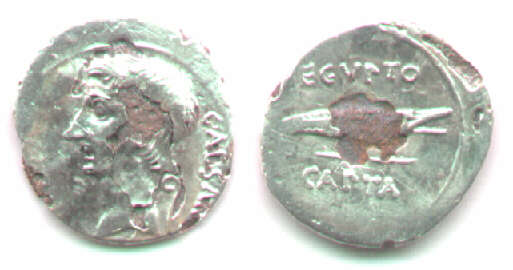 19-17 mm. 6:00. 2.82 grams
19-17 mm. 6:00. 2.82 grams
An excellent fourree with very clear breaks in the foil over the ear and the middle of the crocodile.
CAESAR COS VI, bare head of Augustus left, lituus behind
/AEGYPTO CAPTA above and below crocodile (represeting Egypt) right
Prototype: SM.1564 under Octavian, stuck 28 BC before he became Augustus.
 20 mm. 3:30.
20 mm. 3:30.
Hybrid type of emperor's head right, DIVI F AVGVSTVS
/kneeling Parthian kneeling right, presenting standard marked X
CAESAR AVGVSTVS SIGN RECE
[This reverse is not officially paired with the emperor's head]
Commemorates the event of 20 BC.
BMC plates 1.7-9, 2.2, 2.11-12 (18 BC)
BMC 71, plate 3.1 for obverse legend and portrait
 19 mm. 4:30. 3.56 grams.
19 mm. 4:30. 3.56 grams.
A super fourree of highest style. Only the break at 11:00 where the foil is clear makes it obvious this is a fourree. It had fooled the dealer until I pointed it out. The style is very close to the aureus of this type, BMC plate 7.10.
Obverse: no legend, laureate bust right
/FORT RED/CAES AVG/SPQR inscribed on a square altar
RIC 54a, "Spain", "R2" page 45. BMC 359a, page 64, plate 7.11 (3.62 grams).
Sear M 1608var with bust right.
 18-17 mm. 6:00. 2.00 grms.
18-17 mm. 6:00. 2.00 grms.
DIVI F AVGVSTUS (from 5:00, counterclockwise)
/IMP X across field, ACT in exergue, the Actian Apollo standing left, holding plectum and lyre (much corroded)
Prototype: SM 1611. RIC 171a, plate 3, 15-13 BC.
Tiberius (AD 14-37)
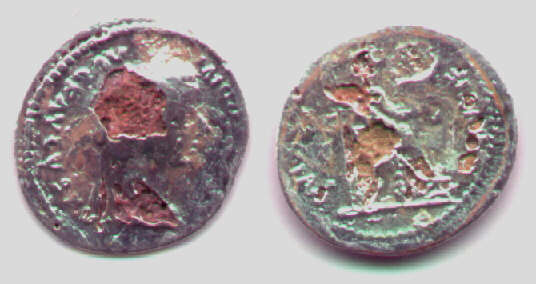 19 mm. 9:00. 1.99 grams.
19 mm. 9:00. 1.99 grams.
The "tribute penny". Much red copper shows where the silver-plating has broken.
TI CAESAR DIVI F AVGVSTVS, counterclockwise from 5:00
/PONTIF MAXIM, counterclockwise from 4:00, Livia(?) seated right
Prototype: SM 1763. RIC 26, struck at Lugdunum.
Nero (AD 54-68)
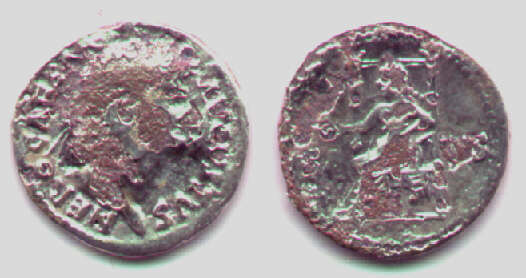 19 mm. 3:00. 2.29 grams.
19 mm. 3:00. 2.29 grams.
Silvering largely broken, but name clear.
NERO CAESAR AVGVSTVS
/SAL - VS across field, Salus seated left, holding patera
Prototype: SM 1945v (SALVS in field, not exergue). RIC 72 "rare" struck c.67-68.
Vespasian (AD 69-79)
 18 mm. 6:00. 2.44 grams
18 mm. 6:00. 2.44 grams
Good portrait in slightly odd style
IMP CAESAR VESPASIAN AVG
Reverse largely gone. seated female left .... TR PONT
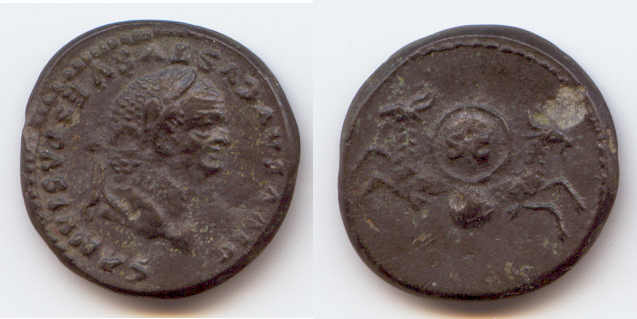 18mm. 6:00
18mm. 6:00
Pitch black, perfect style, casting seem all around, no sign of silver
DIVVS AVGVSTVS VESPASIANVS, laureate head right
/two capricorns supporting circular shield with "SC" on it.
Ref: Sear 1:2569 under Titus. RIC 63. BMC 129
A cast imitation.
Titus (AD 79-81)
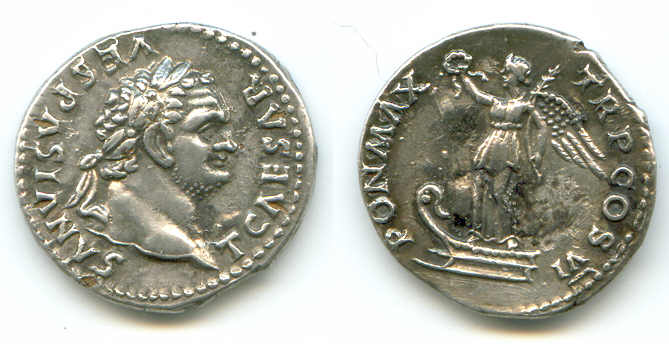 19 mm. 6:00. 3.06 grams.
19 mm. 6:00. 3.06 grams.
Superb! Fourree. Only the most minor break in the silvering just off the tip of the nose, at 5:30, and at 1:00 on the reverse.
There are some scratches in the reverse fields where corrosion was removed.
T CAESAR VESPASIANVS, laureate head right
/PON MAX TRP COS VI, Victory on large prow left, she holds wreath and palm
Ref. A hybrid of an obverse of Titus and a reverse of Vespasian.
Obverse legend of AD 77-79, BMC 227-230, page 41f, and 316-321, p.54f, under Vespasian, and 3 hybrids (#56-59) mentioned on page 65. The reverse is of hybrid 53, p. 65 and Vespasian 167, page 31, plate 5.2. See also notes on page 40 for plated hybrids with this reverse. COS VI of Vespasian is AD 75.
Domitian (AD 81-96)
 18 mm. 6:00. 3.10 grams
18 mm. 6:00. 3.10 grams
Edges almost intact but cracks show copper beneath.
IMP CAES DOMITIANVS AVG PM counterclockwise, reading outwards
/IMP XXI COS XVI CENS PPP Minerva left with thunderbolt in right and long vertical spear in left, round shield at feet right.
The thunderbolt is dotted like the edge of the shield.
Prototype: BMC 181, page 335, plate 65.9 (3.19 grams) has this reverse, but with a clockwise obverse legend. Reverse of AD 90-91.
ex CNG 61
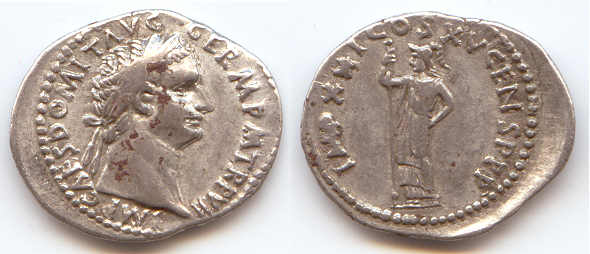 22-18 mm. 6:00. 2.61 grams.
22-18 mm. 6:00. 2.61 grams.
Dark adhesions, but no breaks in the silver. Quite light weight.
IMP CAES DOMIT AVG GERM PM TRP VII
/IMP XXI COS XV CENS PPP, Minerva standing left holding long vertical scepter.
Prototype: BMC reverse of 168, plate 65.2, p.333 "AD 90" but normal obverse legend ends TRP VIIII, not VII, which is from 88.
ex CNG 61
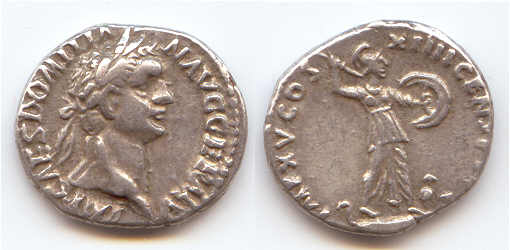 18 mm. 6:00. 3.28 grams.
18 mm. 6:00. 3.28 grams.
No break in the silver.
IMP CAES DOMITIA-N AVG GERM V
/IMP XV COS XIIII CENS ... Minerva fighting right on prow, tiny owl at feet right.
BMC -- for this obverse legend. Year TRP XV COS XIIII is the "second issue" of AD 88, page 326, but not with this obverse legend.
ex CNG 61
 17 mm. 6:30. 3.20 grams.
17 mm. 6:30. 3.20 grams.
No break in the silver. The thickness of the flan is not constant, but greater from 2:00 - 7:00..
....DOMIT AVG - GERM PM TRP IIII (if it begins IMP CAES it would be a known obverse legend of AD 85).
TRP .... CENS PPP
Minerva fighting right on prow, tiny owl at feet right.
The "prow" of the reverse is more than just the prow, really the whole ship. This is clearer on this imitation than it is on most official pieces.
The obverse legend ending in TRP IIII is from AD 85. It is not usual for the reverse to also mention TRP. Unfortunately, the reverse date is off the flan.
ex CNG 61
 19 mm. 6:00. 2.46 grams
19 mm. 6:00. 2.46 grams
IMP CAES DOMIT AVG GERM PM TRP XII
/IMP XII COS SVI [CENS PPP]
Minerva standing left holding thunderbolt and spear, with shield on ground right
Prototype: BMC 205, plate 66.1 (both sides match) "92-93". RIC 177, page 174.
 17-18 mm. 6:00. 2.25 grams
17-18 mm. 6:00. 2.25 grams
Excellent engraving that could pass for official
IMP CAES DOMIT AVG GERM PM TRP XII
/IMP XXI COS XVII CENS PPP
Minerva standing left holding thunderbolt and spear, with shield on ground right
Prototype: RIC 168 "AD 92"
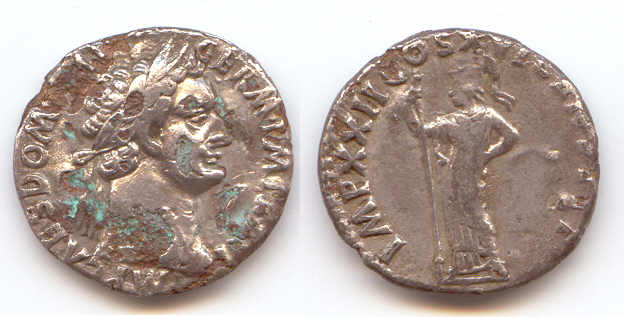 17mm. 6:00.
17mm. 6:00.
IMP CAES DOMIT GERM PM TRP [XII] , laureate head right
/IMP XXII COS XVI [CENS PPP], Minera standing left with vertical spear
Sear 1:2736. ROC 180 "AD 93-94" p. 175.
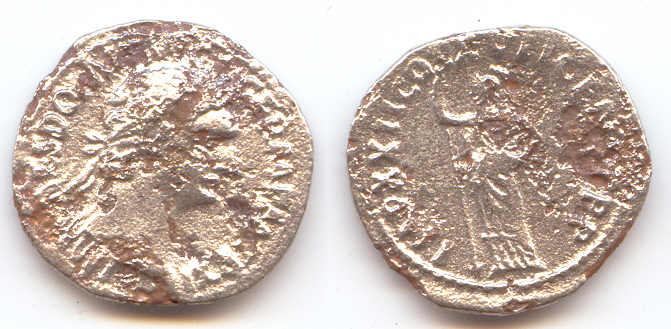 19mm. 6:00.
19mm. 6:00.
IMP CAES DOMIT AVG GERM PM TR XI [It is hard to see, but there is no "P" in "TRP"], laureate head right
/IMP XXII COS XVII CENS PPP, Minera standing left with vertical spear
Ref: Sear 1:2731 obverse, 2737 reverse date.
RIC 169 on p.173 has TRP XI with IMP XXI and 174 has TRP XII ith IMP XXII COS XVI. 189 has TRP XIIII/IMPXXII COS XVII as this reverse (AD 95).
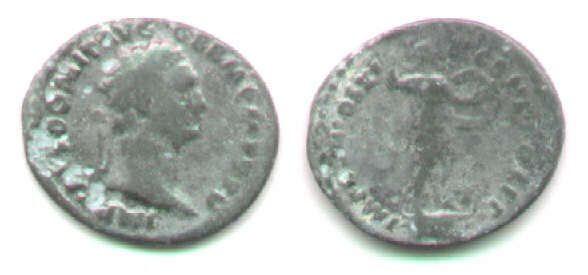 20-18 mm. 6:00. 2.53 grams.
20-18 mm. 6:00. 2.53 grams.
Very glossy gray cast -- not a fourree. No signs of an edge seam. There is one tiny brassy spot on the edge.
The softness of the details is typical of casts.
IMP DOMIT AVG GERM PM TRP V
/IMP VIIII COS XI CENS POT PP, Minerva right
Prototype: RIC 63, struck for about 3-3.5 months before 13 Sept AD 85.
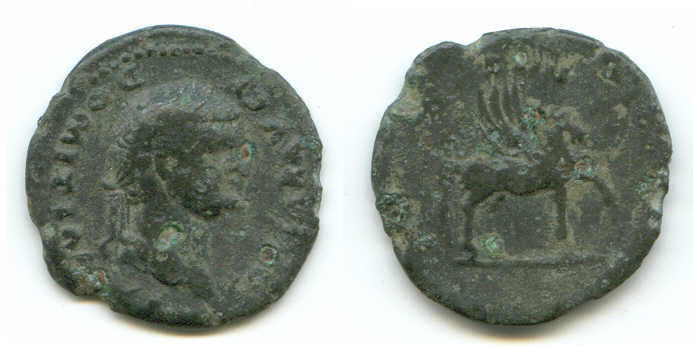 19mm. 6:00. 2.56 grams.
19mm. 6:00. 2.56 grams.
Gray base metal. Weak details. Likely a cast, but the edges do not show signs of casting.
CAESAR AVG F DOMITIANVS (counterclockwise), laureate head right
/COS IIII above Pegasus right
Prototype: Sear 1.2637 (AD 76). BMC (Vespasian) 193, page 36, plate 6.1
Continue with the next page, "Fourrees: The Second Century."
Return to the main Table of Contents page.
 19-17 mm. 6:00. 2.82 grams
19-17 mm. 6:00. 2.82 grams 20 mm. 3:30.
20 mm. 3:30. 19 mm. 4:30. 3.56 grams.
19 mm. 4:30. 3.56 grams. 18-17 mm. 6:00. 2.00 grms.
18-17 mm. 6:00. 2.00 grms. 19 mm. 9:00. 1.99 grams.
19 mm. 9:00. 1.99 grams. 19 mm. 3:00. 2.29 grams.
19 mm. 3:00. 2.29 grams. 18 mm. 6:00. 2.44 grams
18 mm. 6:00. 2.44 grams 18mm. 6:00
18mm. 6:00 19 mm. 6:00. 3.06 grams.
19 mm. 6:00. 3.06 grams.
 22-18 mm. 6:00. 2.61 grams.
22-18 mm. 6:00. 2.61 grams. 18 mm. 6:00. 3.28 grams.
18 mm. 6:00. 3.28 grams. 17 mm. 6:30. 3.20 grams.
17 mm. 6:30. 3.20 grams. 19 mm. 6:00. 2.46 grams
19 mm. 6:00. 2.46 grams 17-18 mm. 6:00. 2.25 grams
17-18 mm. 6:00. 2.25 grams 17mm. 6:00.
17mm. 6:00. 19mm. 6:00.
19mm. 6:00. 20-18 mm. 6:00. 2.53 grams.
20-18 mm. 6:00. 2.53 grams. 19mm. 6:00. 2.56 grams.
19mm. 6:00. 2.56 grams.